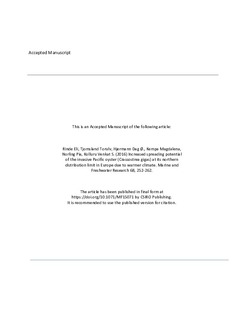Increased spreading potential of the invasive Pacific oyster (Crassostrea gigas) at its northern distribution limit in Europe due to warmer climate
Rinde, Eli; Tjomsland, Torulv; Hjermann, Dag Ø; Kempa, Magdalena; Norling, Pia Carina; Kolluru, Venkat S.
Journal article, Peer reviewed
Accepted version
Permanent lenke
http://hdl.handle.net/11250/2562588Utgivelsesdato
2016Metadata
Vis full innførselSamlinger
- NIVA-rapporter [7006]
- Publikasjoner fra Cristin - NIVA [2160]
Sammendrag
The Pacific oyster, Crassostrea gigas, is an invasive species with a large increase in prevalence globally, and with potential of spreading even more because of climate-change effects. We examined how future climate might affect its potential for spread at its northern distribution limit in a temperate ecoregion, by simulating spawning, larval dispersal, larvae settlement and adult survival, given different climate scenarios. The simulations were performed using a three-dimensional current model (GEMSS) and a specially designed oyster module, applied at the study site in the Oslofjord, Norway. The simulations showed that the expected climate in the middle and latter part of this century, with warmer summers and winters, very likely will lead to increased prevalence of the species within northern Europe. The warmer summers will more often provide favourable temperature conditions for oyster spawning and settlement, and warmer winters will more seldom cause high winter mortality. The simulations gave a realistic picture of the relative frequency and the main distribution pattern observed, given the current climate. The future climate-scenario simulations indicated influence of local differences in temperature on the dispersal pattern. The study indicated increased dispersal and successful establishment at the outer edge of the species present distribution in the future and, hence, an increased risk to native species and habitats in temperate regions.
